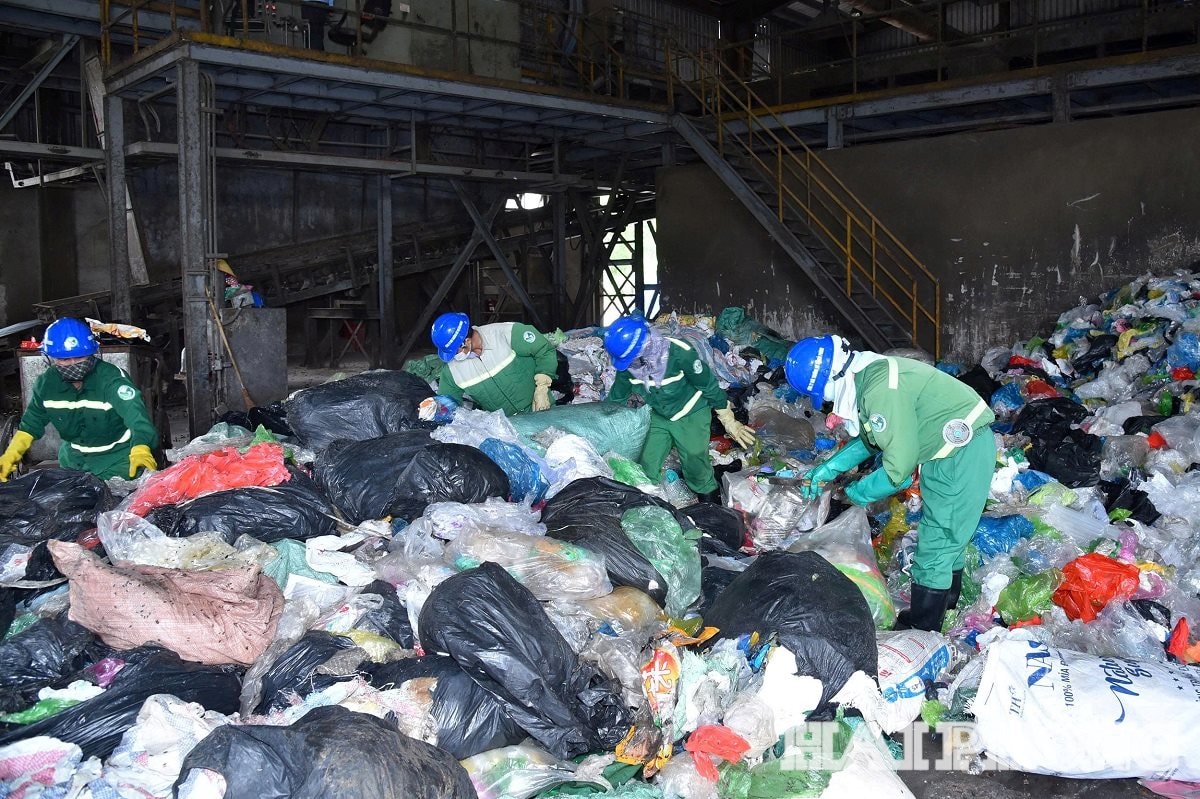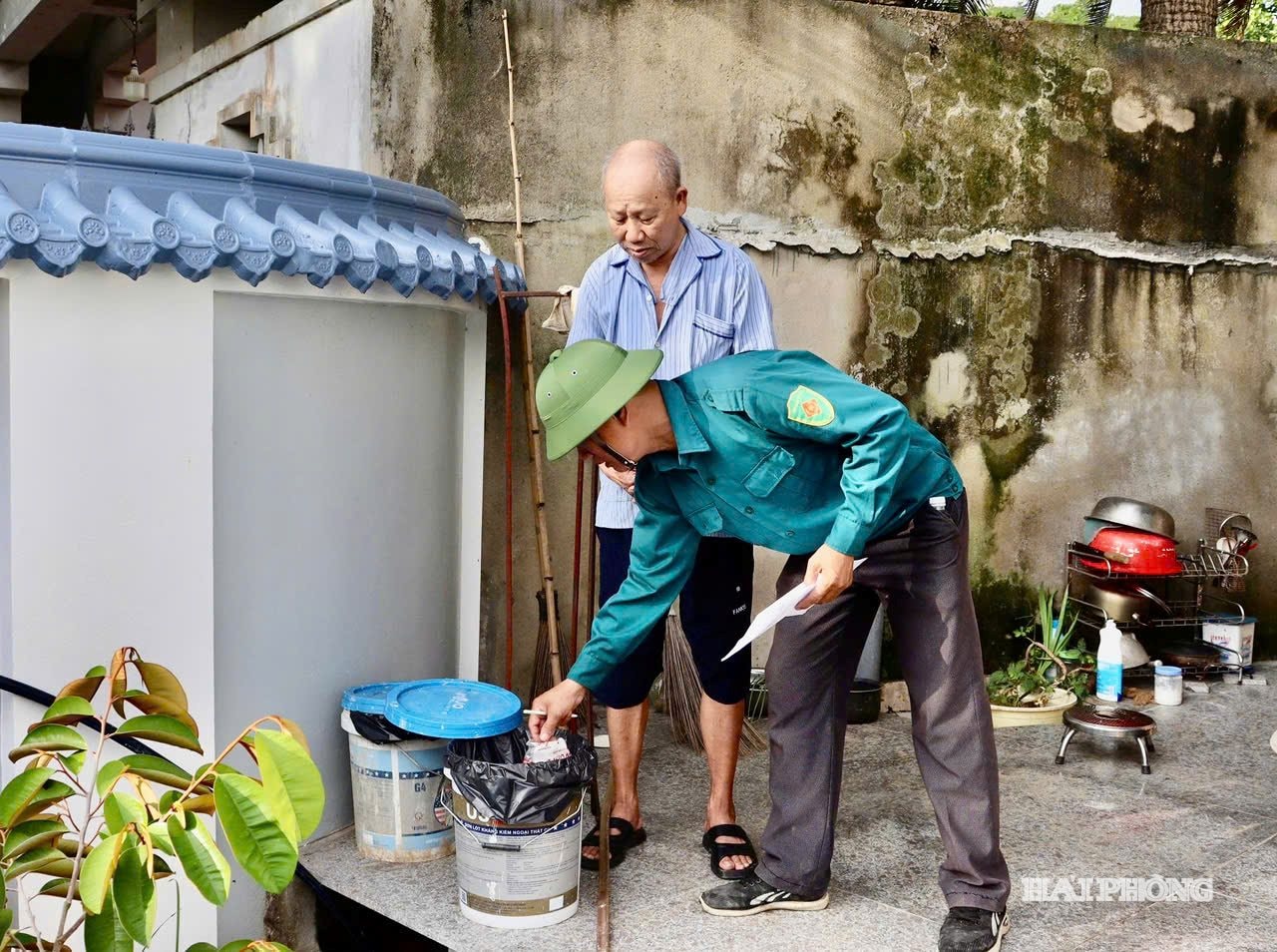
According to the Law on Environmental Protection 2020, the regulation on classifying household waste at source officially took effect from January 1, 2025, opening up expectations of changing waste treatment habits and reducing landfill pressure. However, in the past 8 months, in addition to some achieved results, the implementation of this regulation has encountered many shortcomings, especially in the collection, classification and treatment of household solid waste in large urban areas, including Hanoi , Ho Chi Minh City, and Hai Phong.
Many problems
According to the report of the Ministry of Agriculture and Environment , as of June 30, the total amount of domestic solid waste generated in the country was about 69.4 thousand tons/day, with a treatment rate of 91%; of which, urban areas generated about 37.25 thousand tons/day, with a treatment rate of 97.28%; rural areas generated about 32.15 thousand tons/day, with a treatment rate of 80.5%, with a landfill rate of about 59.32% (a decrease of 30% compared to 2012). The amount of waste generated in Hanoi alone was about 7,300 tons/day and waste generated in Ho Chi Minh City was about 14,000 tons/day, the total amount of waste from the two cities accounted for about 23% of the country's waste. Currently, Hai Phong generates about 2,010 tons of domestic solid waste every day.
Regarding the classification of domestic solid waste, localities are currently mainly at a small scale, piloting. In Hanoi, the city directs districts, towns (now wards and communes) to arrange collection and transfer points for domestic solid waste after classification to meet technical requirements for classification, collection and transportation.
In Ho Chi Minh City, currently, domestic solid waste is treated by the following methods: sanitary landfill, incineration without energy recovery, compost production (organic fertilizer),... To achieve the target by 2025, the rate of domestic waste treatment by modern new technology (incineration to generate electricity) and recycling will reach at least 80% (aiming to reach 100% by 2030).
In Hai Phong, solid waste is mainly treated by sanitary landfill methods at three major treatment areas: Trang Cat, Dinh Vu, Gia Minh, but there are still many temporary landfills that do not meet standards. The city also applies the method of producing bio-fertilizers at Trang Cat Treatment Area, but the capacity is limited. In addition, small-scale incinerators are used in rural areas, but only treat a small portion of the waste.
According to Deputy Director of the Department of Environment (Ministry of Agriculture and Environment) Ho Kien Trung, the classification and treatment of domestic solid waste still faces many difficulties and obstacles due to the lack of technical infrastructure for classification, collection, transportation, and treatment of domestic solid waste after classification. This leads to a lack of technical infrastructure for the collection, transportation, and treatment of domestic solid waste after classification, especially the lack of infrastructure and technology to recycle and treat food waste and organic waste, which account for a large proportion (about 50 to 60% of the total waste volume) to convert into biomass energy (humus, compost, biomass electricity, etc.) or to process into animal and poultry feed.
Along with that, mechanisms to mobilize social resources for waste collection, classification, recycling and treatment have been available, but implementation is still limited, so mobilized resources have not met the demand. The principle of "Polluters must pay for treatment costs" has not been thoroughly applied, especially the lack of collection of full collection, transportation and treatment service fees, so it has not promoted private resources to invest in collection, transportation and treatment of domestic solid waste.

Focus on solutions
From the above reality, Mr. Ho Kien Trung said that the Ministry of Agriculture and Environment identified a number of short-term and long-term solutions that need to focus on promoting the classification and treatment of domestic solid waste.
For immediate solutions, in 2025 and 2026, the Ministry of Agriculture and Environment will focus on reviewing shortcomings in the management of domestic solid waste in the Law on Environmental Protection and the Decree to propose amendments and improvements; issue a Circular promulgating national environmental technical regulations on domestic solid waste landfills; Circular guiding a number of contents in investment activities under the public-private partnership method in the field of domestic solid waste treatment, etc.
Localities urgently develop and promulgate technical processes, economic and technical norms, promulgate maximum prices and specific prices, and forms of collection of prices for collection, transportation, and treatment of domestic solid waste according to the mass or volume of domestic solid waste to be treated for each type according to the requirements of the Law on Environmental Protection 2020.
The Ministry of Agriculture and Environment is also advising the Government to report to the National Assembly through the National Assembly's Supreme Supervision Delegation "Implementation of policies and laws on environmental protection since the Law on Environmental Protection 2020 took effect" to have a Resolution of the National Assembly on improving the effectiveness and efficiency of promulgating and implementing policies and laws on environmental protection, which allows research on restructuring budget expenditure tasks for environmental protection in a focused and key direction, focusing on solving long-standing environmental problems; investing in essential environmental infrastructure works such as systems and infrastructure for collecting, classifying and treating domestic solid waste; At the same time, localities are required to urgently develop a medium-term public investment plan for the period 2026 - 2030, focusing on mobilizing all resources to build synchronous and modern technical infrastructure for collecting, classifying, transporting, recycling and treating waste, applying advanced and environmentally friendly technologies;
The Ministry is also advising the Government to issue a Resolution on "Promoting the mass movement to protect the environment, focusing on classifying, collecting, recycling, and treating waste for a bright - green - clean - beautiful Vietnam" to achieve the goal of maintaining and spreading the mass movement to protect the environment, focusing on classifying, collecting, and treating waste for a bright - green - clean - beautiful Vietnam. According to the draft Resolution, the Government requires ministries, ministerial-level agencies, government agencies, and People's Committees of provinces and centrally run cities to specify, develop specific plans, and organize the implementation of the following tasks: Promote propaganda, raise awareness of classifying, collecting, transporting, recycling, and treating waste; Invest in and complete synchronous technical infrastructure for classifying, collecting, transporting, recycling, and treating waste after classification; Diversify investment resources for classifying, collecting, transporting, recycling, and treating waste.
In the long term, the Ministry of Agriculture and Environment will continue to work with ministries, branches and localities to strengthen propaganda, mobilization and guidance to raise public awareness of the management and classification of domestic solid waste through television programs, community communication and pilot models, creating a strong change in awareness and building an environmentally friendly lifestyle for people; mobilizing and seeking international projects to build capacity and technical infrastructure for localities to effectively collect, classify, recycle and treat waste; promoting the implementation of the responsibility policy of organizations and individuals producing and importing in the collection, recycling and treatment of waste from products and packaging produced and imported by enterprises (extended responsibility policy of manufacturers and importers - EPR) to mobilize the responsibility and resources of enterprises in the collection, classification, recycling and treatment of waste.
Localities need to immediately deploy synchronous investment in technical infrastructure from classification, collection, transportation, and treatment of domestic solid waste after synchronous classification, in accordance with the province's planning after the merger as soon as the National Assembly and the Government issue medium-term public investment projects for 2026 - 2030; continue to promote, regularly and long-term propaganda work, mobilize the participation of the whole society in environmental protection, in which the Vietnam Fatherland Front and member organizations such as the Youth Union, Women's Union, Veterans Association, Farmers' Association, and Labor Federation play a core role in organizing, guiding, and supervising the implementation of minimizing the generation, classification, collection, transportation, recycling, and treatment of domestic solid waste.
PV (synthesis)Source: https://baohaiphong.vn/bat-cap-trong-phan-loai-xu-ly-chat-thai-ran-sinh-hoat-520253.html







![[Photo] Cat Ba - Green island paradise](/_next/image?url=https%3A%2F%2Fvphoto.vietnam.vn%2Fthumb%2F1200x675%2Fvietnam%2Fresource%2FIMAGE%2F2025%2F12%2F04%2F1764821844074_ndo_br_1-dcbthienduongxanh638-jpg.webp&w=3840&q=75)

























































![[VIMC 40 days of lightning speed] Da Nang Port: Unity - Lightning speed - Breakthrough to the finish line](https://vphoto.vietnam.vn/thumb/402x226/vietnam/resource/IMAGE/2025/12/04/1764833540882_cdn_4-12-25.jpeg)












































Comment (0)